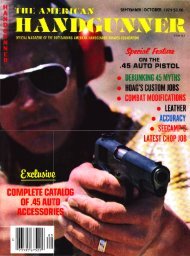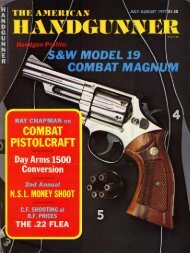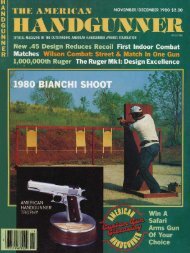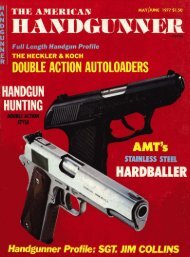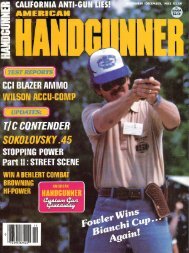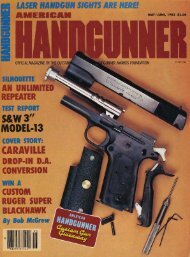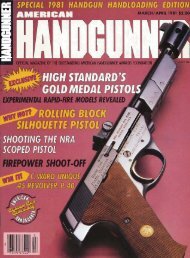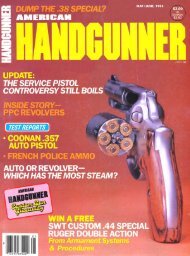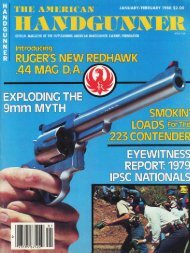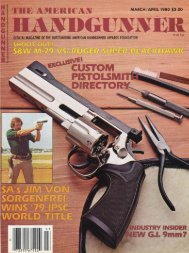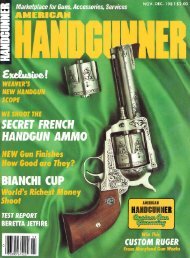March/April 1983 - American Handgunner
March/April 1983 - American Handgunner
March/April 1983 - American Handgunner
Create successful ePaper yourself
Turn your PDF publications into a flip-book with our unique Google optimized e-Paper software.
Gets high marks...The <strong>American</strong> handgunner is blessedwith a multitude of factory loadings..Highly responsive to his needs, U.S. ammomakers have put forth a herculean effort tosatisfy his appetite in both standard andhigh-performance cartridges.They have kept on the market-in spiteof comparatively low sales-handguncartridges still used by relatively fewshooters. Included are such calibers as the.32 S&W, .38 Auto Pistol and the .45 AutoRim. For this we are grateful.Standard factory ammunition has beenwith us ever since the first metalliccartridge firearm entered the shooters'world. In Winchester's case, this can betraced back to about 1866. Remington'sstart in the field began in August of 1867,when a group of entrepreneurs started upUMC (Union Metallic Cartridge Company).This independent company thenmerg~.d with Remington Arms, with headstampsreading REM-UMC. Today, Remingtonbrass is simplystamped R-PTime plays an importantpart in the developmentof center-firecartridges. At this writing,the self-containedcartridge is only about125 years old. Therefore,factory ammunition cantruly said to be still in itsinfancy.Modern technology isconstantly finding betterways to propel that smallprojectile down the bore.If the early 20th centuryballistic fathers, such asNewton, Roberts andWhelen, had thepowders we now have atour disposal they wouldA report on center-fire loads from Federal,Frontier, Remington and Winchester; itfeatures consistent velocities, tight groups.By Stanley Jv. Trzoniechave been truly astonished and extremelypleased at the end results.Time and necessity also brought us greatrounds like the .45 Colt, .45 ACP, .38 Specialand the magnums. Gifted men-PhilSharpe and Elmer Keith, for examplehadthe foresight and talent to see aheadand introduced us to the .357, .41 and .44magnums. The past 20 years or so in thedevelopment of handgun cartridges hasbeen nothing short of exciting, and thetrend continues.COMPANIES MEET NEEDSFads come and go, leaving the ammunitioncompanies in a constant state ofshockover present conditions. Silhouette, combat,target shooting or hunting all havetheir own requirements and, when a vacuumappears, companies such as Remington,Winchester, Federal or Frontier allrush to meet those individual needs.five different calibers, five different powders. Note bullet variations anddifferences in powder granulations. There are no reloads here.Big bucks must first be spent on researchand development, to insure that a qualityproduct will reach the consumer. To calculatethe amount of engineering involved injust getting that modern projectile downrangein one piece, or in one ragged hole, isnothing short of phenomenal.Take the forces against our little bullet,for example. Rotational spin is one. A .357magnum bullet blasting out of the muzzleat roughly 1,200 fps will, in the course ofitstrip, make upwards of 72,000 revolutionsper minute. A .44 Magnum will hit thehigh side at around 95,000 rpm.Then there's gravity. In the trip downrangeto a 100 yard target, a normal .357will, at 1,200 fps, drop more than 13 incheswith no sight compensation as it comesstraight out ofthe muzzle. At 200 yards, it's61 inches; at 300 yards, the bullet will dropmore than 12 feet. This calculates, in flighttime, in the neighborhood of l.!.l, 1/2 and almosta full second-at these respectiveranges.Another importantfactor is pressure. Standardcartridges in the .38Special or .45 automaticdevelop, on the average,of 15,000 copper units ofpressure (cup). Modern,high-performance magnumseasily approach40,000 cup.Copper units of pressuremeasurement is alaboratory-controlledprocedure. When thepowder is ignited by theprimer, a gas is formed. Itbuilds up pressure,which sends the bullet onits way. Test barrels areused in the lab; they incorporatea "copper56 AMERICAN HANDGUNNER . MARCH/APRIL <strong>1983</strong>



